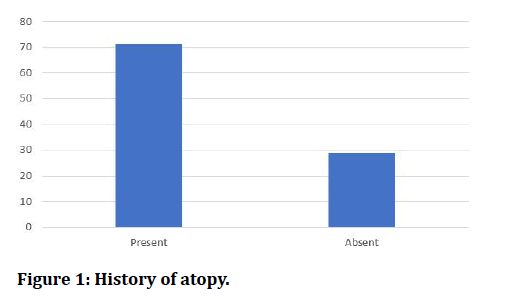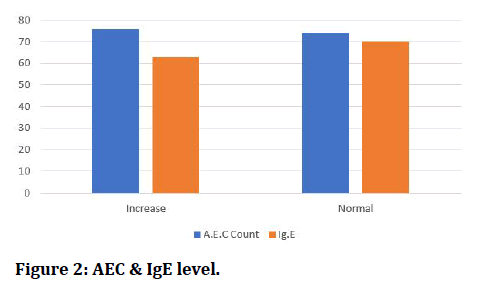Research - (2021) Volume 9, Issue 7
A Study of Papular Urticaria and Atopy
*Correspondence: Raneesha PK, Department of Dermatology Venereology and Leprosy, Sree Balaji Medical College & Hospital Affiliated to Bharath Institute of Higher Education and Research, India, Email:
Abstract
The minimum age of onset was 37 days, and the maximum was to 38 years. With the mean age of 9.1 years. 50% of our patients affected were under 5 years of age. Out of 107 patients 38 patients (35.5%) had personal history of Atopy and 69 patients (64.5%) had family history of Atopy. serum IgE levels was elicited in all the patients (150) out of which 76 patients (50. 7%) showed increased absolute eosinophil count values and 63 patients (42%) showed increased in serum IgE levels. 52 patients (34.7) had both levels elevated.
Keywords
Esonophil, atopy, IgE
Introduction
Popular urticaria is a result of hypersensitivity, majorly Type I hypersensitivity which is manifested by chronic or recurrent papules. The pathogenesis is caused by the disseminated antigen deposited because of an arthropods bite. The lesions caused because of this infection may last for almost a week tom months.it can even lead to hyperpigmentation [1-2]. Hence this study aims to determine the association between popular urticaria and atopy and to evaluate the serum Igg and eosinophil level during such infection.
Methodology
Patients (150Nos) who are clinically diagnosed as papular urticaria are taken for the study. Complete physical examinations were done, and familiar history of atopy was studied. serum IgE and eosinophils levels were estimated.
Results
Out of 150 Patients tests, 107 Patients had history of Atopy (Either Family History or Personal History) and 43 patients had no such history. Out of 107 patients with history of Atopy, 38 patients (35.5 %) had personal history of atopy and 69 patients (64.5%) had family history of atopy (Figure 1). 76 Patients (50.7%) had increase in absolute eosinophil count and 63 Patients (42%) had increase in Serum IgE Levels (Figure 2).

Figure 1: History of atopy.

Figure 2: AEC & IgE level.
Discussion and Conclusion
The results of serum AEC and IgE confirms that the atopy patients have a persistent Th2 response with high IgE production which was like the study done by Thomas et al [3-10]. when observing the lesion in the study group all had only in hands and legs. Few patients also had some other disorders like Cutaneous Atopic Disease (CAD) eczema, and Methicillin Resistant Staph Aureus (MRSA) infection. serum IgE levels was elicited in all the patients (150) out of which 76 patients (50. 7%) showed increased absolute eosinophil count values and 63 patients (42%) showed increased in serum IgE levels. 52 patients (34.7) had both levels elevated. The severity of papular urticaria has some positive correlation with the increased absolute eosinophil count and serum IgE levels. The history of atopy plays a significant role in this study as it reflects a strong association between atopy, popular urticaria, AEC, IgE levels. This tool is a promising element to simplify the diagnosis of this diseases which can help to prevent a child from going to atopy.
References
- Stibich AS, Schwartz RA. Papular urticaria. Cutis 2001; 68:89-91.
- Garcia E, Halpert E, Rodriquez A, et al. Immune and histopathologic examination of flea bite-induced papular urticaria. Ann Allergy Asthma lmmunol 2004; 92:446-52.
- Jayakar T, Selva PS, Manoharan D, et al. Papular urticaria-An early marker of atopic march. Sudanese J Dermatol 2010; 8.
- Rivers JK, Martin J, Pukay B. Walking dandruff and cheyletiella dermatitis. J Am Acad Dermatol 1986; 15:1130-1133.
- Chesney TM. Bites and infestations. In: Farmer ER, Hood AF. Pathology of the skin. Norwalk (CT): Appleton and Lange 1990; 390-394.
- Allen AC. Persistent "insect bites" dermal eosinophilic granulomas simulating lymphoblastomas, histiocytoses, and squamous cell carcinomas. Am J Pathol 1948; 24:367-368.
- Brown J, Schwartz RA. Wells' syndrome (eosinophilic cellulitis). Cesko-Slovenska Dermatol 2002; 77:261-263.
- Elston DM, Stockwell S. What's eating you? bedbugs. Cutis 2000; 65 :262-4.
- Scharf MJ, Daly JS. Bites and stings of terrestrial and aquatic life. In: Freedberg IM, Eisen AZ, Wolff K, et al. Fitzpatrick's dermatology 1n general medicine. New York: McGraw-Hill; 2003; 2261-2298.
- Karppinen A, Kautiainen H, Petman L, et al. Comparison of cetirizine, ebastine, and loratadine 1n the treatment of immediate mosquito-bite allergy. Allergy 2002; 57:534-7.
